Skin Tags
According to estimatesi nearly every second person (or 50% of the population) has skin tags.
Despite the prevalence of skin tags, little is known about the physiology of why skin tags grow, but we have fortunately learnt much more about what causes skin tags, and hence how to prevent them and also to treat them.
In learning about the causes of skin tags, we have also found that skin tags are often a very useful early warning sign of impending ill health, such as diabetes typeII. |
Contents:
-
Introduction
-
Fibroma skin tags - description, symptoms and signs, and photo
-
The common skin tag - description, symptoms and signs, and PHOTOS / PICTURES
-
What are skin tags?
-
What causes skin tags?
-
Should I Worry About My Skin Tags?
-
Skin tags references
|
|
Predominantly skin tags are usually small, benign, non cancerous growths that don’t pose any threat to the health of the individual.
However, skin tags can also be very large (about the size of a grape) and almost unbearable to live with.
There is also a rare type of skin tags, called fibroma.
Fibroma skin tags - description, symptoms and signs, and photo
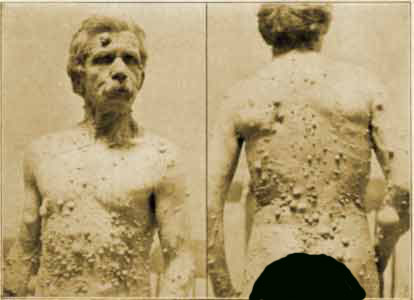
The picture of fibroma skin tags above, shows how much this man must have suffered with skin tags. The blacked out area is to conform to google adsense policy. |
Fibroma skin tags are extremely large and numerous.
Fibroma skin tags are more the size of peas, and sometimes even egg size, and frequently start out small, growing a little every year.
Fibroma skin tags are a very rare type of skin tag.
The great majority of us suffering with skin tags, suffer with small, pendulous sacs called fibroma
simplex, or acrochordon - the common skin tag.
The medical removal of, treatment for, both types of skin tags is often the same though. |
The remainder of this site focuses on the common skin tag, and when the term skin tag is used, it is being used to refer to the common skin tag.
My System will safely remove skin deformities without leaving behind scars or any signs of scaring- ebook ad
The common skin tag - description, symptoms and signs, and pictures / photos.
Photos and pictures of skin tags
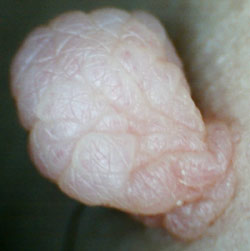 |
LEFT: The skin tag photo was taken by me, and is, of course, under copyright by me, as are the next two photos. |
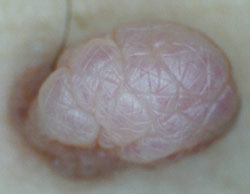 |
It is a skin tag that was growing in the groin area, and is a very close up perspective. The skin tag has the larger top part, and the narrower base, which is very typical of a common skin tag. For reference purposes, this skin tag is about 2-4 millimetres across.
RIGHT: This is the same skin tag, but taken from a top view perspective, again, really close up.
More Skin Tag Photos and Comments
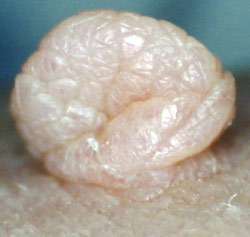 |
LEFT: The photo is a close up side perspective of a skin tag growing on a leg. Again, you can see the narrower base and the wider top bit. |
| Photo removed to conform Google Adsense Policy |
A skin tag on the breast has likely been caused by the sucking and chewing of a baby or infant on the nipple/areola. Not your typical skin tag by the way, and it may reabsorb back into the body. |
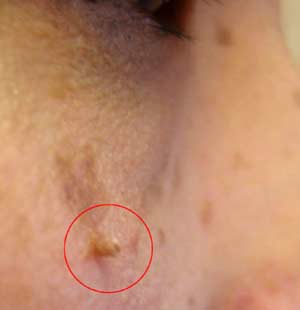 |
In this photo of a skin tag above, you can see that the skin tag is on the cheek, well below the eye. A single skin tag like this, on what appears to be a young face, suggests genetics may have played a role. |
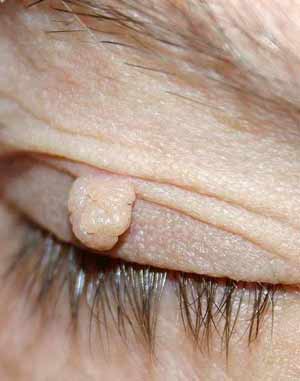 |
The classic type skin tag on the eye lid can be seen in this skin tag picture. This skin tag may have been caused by repeatedly rubbing the eye frequently. Again you will see the narrower base and the wider top bit. |
 |
A cluster of skin tags can be seen in this photo of skin tags found in the arm pit area. What caused these skin tags? May have been tight fitting singlets that cut in, in the armpit area. This skin tag photo looks very much like one these warts photos. If your skins tags look like these ones, there is a possibility that they may be a type of wart, and it is suggested that a medical check should be made.
Skin tags in armpits normally look like those in the close up photos I took above, they also don't normally cluster like that either in such great numbers - those in the photo just above do not look like your typical armpit skin tags. |
Where do skin tags occur?
Although skin tags may appear anywhere on the body, they are more commonly found on the neck, armpits (axillae), beneath the breast, on the eyelids, and in the groin and perianal area.
Some people develop clusters of skin tags dangling in visible body parts like the eyelids and neck.
Skin tags of the genitalia are especially embarrassing to those who are sexually active since their partner may mistake them for some type of venereal disease.
When skin tags are profuse in number, skin tags may occur on the face, chest, and back.
What do skin tags look like?
Some skin tags are wrinkled, some skin tags look filled out. Either way they appear to hang off the surounding skin by a more slender stalk.
How do skin tags change as they grow?
Skin tags usually first appear as tiny bumps resembling pimples. As they grow they turn into a protruding piece of skin that appears attached by a stalk.
What is the color of a skin tag?
Usually skin tags will remain the same color as the surrounding skin (hence the name “skin tags”) but there are those that will have a slightly darker appearance.
What is the size of a skin tag?
Skin tags range in size from 1 mm to 1 cm in diameter and some will grow to the size of a grape.
How many skin tags can one get?
Where there is one skin tag, you will often find several hanging off the skin.
Some individuals have numerous skin tags in colossal numbers.
The majority of people have no more than three skin tags per localization, but the frequency and number increase with advancing age and obesity.
Do only girls or guys get skin tags?
Both males and females have skin tags.
How prevalent are skin tags?
60% of the population get skin tags by age 65.
Are skin tags painful?
Skin tags are usually soft and painless, although they can become irritated if they are rubbed a lot.
What this skin tag web site is all about:
In all these cases, skin tags can cause a lot of worry and affect the overall self esteem of the person.
This web site is going to give an overview of skin tags. It’s designed to help you understand more about what skin tags are and what you can do to remove skin tags.
What are skin tags?
Skin tags, also known as “acrochordons” or “cutaneous papilloma”, are benign, non-cancerous skin tumors that hang off the skin by a connecting stalk.
If you were to examine a skin tag under the microscope, histologic examination would reveal tissue composed of fibrous collagen fibers and dilated capillaries, indicating that a skin tag is softer, more elastic, and about as vascularized as the surrounding skin.
The use of skin tags for reconstruction of the ear has been well documented. Very recently the use of skin tags for use in reconstruction of the nose was reported.ii
However, although skin tags may be harmless:
In defining skin tags here, we are defining a common type of skin tag - that which most people mean when they talk of skin tags. However, another definition of skin tag is any piece of skin that sticks out from the rest. So a person could suffer, for example, from anal skin tags, which is a type of skin tag caused by a hemorrhoid stretching the skin - when the hemorrhoid goes away, the little bit of stretched skin remains sticking out, this is not the common type of skin tags talked about here, but it is none the less a skin tag.
What Causes Skin Tags?
What mechanism triggers skin tags to develop is not known, but we do know something about what causes skin tags.
The following have been found to cause skin tags:
-
Skin tags can be caused by rubbing or friction of the skin.
-
The human papillomavirus (HPV) has been implicated because HPV DNA were found in a high percentage (88%) of skin tag biopsies obtained from 49 patients.
iii Skin tags are known to develop in areas of frequent skin friction, leading to disruption of skin which might serve as a route of entry for the virus.
-
It is also known that some medical conditions such as obesity, diabetes, insulin resistance and atherosclerosis are associated with more frequent skin tags.
-
Skin tags can also be seen in pregnancy.
-
On average, people are more likely to develop skin tags if they are born to parents who have the same type of skin growths. Forty-four percent of patients with skin tags gave a history of skin tags in other family members. Thus one cause of skin tags is heredity, or a genetic tendency to develop skin tags.
A number of studies have reported an increased incidence of skin tags with obesity and or diabetes
Examination of 110 patients with skin tags revealed that 26.9 percent where obese and 42 percent were overweight.iv Skin tags were most commonly seen on the neck and in the axillae and groin. The neck also had the greatest number of skin tags. The total number of skin tags/patient was 25 and the mean age of onset of skin tags was 42 years.v
Obesity is responsible for a variety of changes in skin physiology and is implicated in a wide spectrum of dermatologic diseases. Considering that nearly two thirds of adult Americans are either overweight or obesevi, the impact of obesity on the skin is profound.
Obese people with skin tags also had a family history of diabetes or were already diabetic and under treatment.
Interestingly, the total number of skin tags was associated with fasting blood glucose levels suggesting a strong association between the number of skin tags and diabetes. In fact, skin tags have been considered a marker of diabetes.
Other disorders that may cause skin tags
An increased frequency of skin tags has also been reported in association with different disorders such as acromegaly, a disorder caused by excessive production of growth hormone, colonic polyps, and Birt-Hogg-Dube syndrome, a rare genetic disorder that affects the skin and lungs and increases the risk of certain type of tumors. vii
Several studies have suggested that skin tags may be a useful and reliable marker for the presence of colonic polyps and may serve as an important advance in the prevention of colorectal cancers.viii However, the results of a recent study refute the theory that an association of skin tags and colonic polyps actually exits.
Should I Worry About My Skin Tags?
No. You should not worry about your skin tags since they are usually benign, non-cancerous growths. Rarely does a skin tag ever become cancerous.
However, if you have skin tags in colossal numbers or on obvious visible body parts like the eyelids and neck they can be aesthetically undesirable and can affect your overall self esteem and well being. In such circumstances, consider having them removed.
Finally, it is always best to try and determine the cause of skin tags, just in case they are an indicator of another health issue that needs treatment.

E-book ad
Skin Tags References
i Banik R, Lubach D: Skin tags: localization and frequencies according to sex and age. Dermatologica 1987; 174:180-183.
ii Eley KA, Pleat JM, Wall SA. Reconstruction of a congenital nasal deformity using skin tags as chondrocutaneous composite graft. J Craniofac Surg 2009; 20: 573-575.
iii Dianzani C, Calvieri S, Pierangeli A, et al. The detection of human papillomavirus DNA in skin tags. Br J Dermatol 1998; 138: 649-651.
iv Rasi A, Soltani-Arabshahi R, Shahbazi N. Skin tag as a cutaneous marker for impaired carbohydrate metabolism: a case-control study. Intl J Dermatol 2007; 46: 1155-1159.
v Yosipovitch G, DeVore A, Dawn A. Obesity and the skin: Skin physiology and skin manifestations of obesity. J Am Acad Dermatol June 2007.
vi F as in fat: how obesity policies are failing in America 2005. Trust for America’s Health. Available at http://healthyamericans.org/reports/obesity2005/.
vii Klein I, Parveen G, Gavaler JS, Van Thiel DH. Colonic polyps in patients with acromegaly. Ann Intern Med 1982; 97: 27-30.
viii Chobanian SJ, Van Ness MM, Winters C Jr, Cattau EL Jr. Skin tags as a marker for adenomatous polyps of the colon. Ann Intern Med 1985; 103: 892-893.
Health Sites







